…. continued from here
As we have already seen in the previous posts, the Roman agricultural authors (see here), in particular Columella, generally tell of a very practical and rational viticulture, which arises from the experience and the careful observation of the phenomena in the vineyard, as we do today, despite the cognitive limits of the time. In the literary or historical works, the agricultural descriptions are very often mixed with the religious rites or the superstitious beliefs, which were certainly widespread in the countryside, especially in relation to the most difficult aspects to manage, such as the soil fertility and vine diseases, of which I tell in this post.

The contraposition between reason and superstition in agriculture is ancient. Mixed between them, they have gone through all the centuries and they have come down to us, the era of the hoaxes and the false myths, which are proliferating more than ever as regards food and its production.
Already Cato disapproved on the winemakers who, instead of learning the vineyard techniques, went to the astrologers, the haruspices or the augurs (in the image below) to decide when to start the harvest or do other works, with bad results! Columella also tried to persuade on the uselessness of the divinations or the other superstitions, such as certain magical practices that were done in the countryside.
The religious rites of that time continued in the processions and blessings of the camps of Christianity, which remained in use until not long ago in our countryside. Today the religious dimension has almost completely disappeared. Instead, the irrational approaches, that seemed to have definitively gone in the modern era, are increasingly emerging in the recent years. Among other things, as you will see, they are very similar to those who were already deprecated by the agronomists of the ancient era.
Is it possible that nothing has changed?
In the past, there was a real naivety towards the irrational, which was explained by the widespread ignorance. However, the today’s generalized education does not seem to have changed much the situation. We seem more than ever at the mercy of false myths, hoaxes, fears, pseudo-ancient practices, etc.
On the other hand, I can understand that for many people it is not easy to defend oneself: there is a great confusion of information. The agriculture is now very far from the life of most people (and I’m not talking about growing a vegetable garden or an amateur garden). Too many experts or pseudo-such talk about it superficially. In addition, an important role is played by the marketing of food which, perhaps short of other ideas, seems to ride more than ever fears and false evocative stories, helping to consolidate myths or hoaxes.
You can say: what harm can it do? Unfortunately, a lot. We are already seeing repercussions which will become more and more important if we continue in this direction. There are effects on the agricultural policies, the rules, the scientific research guidelines, etc. Think of those practices or products used in agriculture that are prohibited or, vice versa, praised for irrational reasons, rather than real experimentation. In general, all these risks leading us to a general decline in agriculture, with influences on the quality and / or quantity of products and several problems on the future of the sector itself.
However, the ignorance and the superficiality in agriculture are plagues that have always existed, as Columella also tells us. In the preface to his work De re rustica, he already complained how much the agriculture was underestimated. Many people, he writes, attribute the depletion of the soils and the decline of agriculture to the fate, the weather adversity or anything else, while what is often missing is only the knowledge.
Columella invites us to reflect on the fact that, while everyone shares the idea that good education is needed to carry out most professions, the same does not happen for the agriculture, which is also among the most important activities, because without it man cannot feed himself. Yet, too many people practice it (or talk about it, I add) only with superficial knowledge. Thus, the agriculture gets worse and worse and imports of products become increasingly indispensable.
It seems written today!
However, let’s tell now of the themes of the vineyard that interest us, the soil fertility and the vine diseases, and let’s see how they were faced in the time of ancient Rome, both rationally and with the superstition and the magic.
Soil fertility and fertilization
The soil fertility problems are not only modern, but have always played a central role in agricultural concerns.
Since ancient times, the fertility was linked to unexplained events and therefore placed within the supernatural. It was viewed as a sign of favor by the gods or, with its absence, of punishment. All peoples, in all eras, have created religious rites, offerings, sacrifices or magical practices, hoping of having good harvests. Fortunately, however, the humanity has not remained firm only in these aspects: our farmer ancestors, with the reasoning and observation skills linked to the practice, understood that the land needed to be “nourished” with fertilizers so that it could continue to give us its fruits.

Today we know that fertility depends on a set of soil characteristics of a chemical, physical and biological nature. Thanks to them the soil is able to supply (or not) the mineral elements that serve the plants as nourishment. the loss of fertility depends on many factors. Each plant removes nutrients from the soil in which it grows, and it is maximum with an intense cultivation. They are also lost due to leaching phenomena (i.e. the dragging action due to the water passing through the soil), the problems of compaction, erosion, etc. The nutrients must therefore be reinstated in some way!
Returning to the viticulture of the Roman era, the agrarian authors recognized the great importance of the fertilizing of the vineyard. Today we know that the optimal nutrition of the vines is an essential factor for the wine quality. According to Columella, the fertilization must be “frequent, timely and moderate”. Today, we would say something similar, even if more precise, according to the principles of the sustainable integrated viticulture: it must be done appropriately, only when and where it is needed, in response to the specific nutritional needs of each vineyard particle.
Cato recommends to use well matured manure, produced from sheep or horses. The bovine one was not considered optimal at these times. Today, the manure is still used, but it is often difficult to find, especially in the territories where there are no farms. As today, a great importance was also given to the fertilization made with green remains (branches of pruning, stalks, marc, grass, …), which form compost. Today we also know that the manure and the compost are not always sufficient. I will talk about it again: it is a very complex topic.
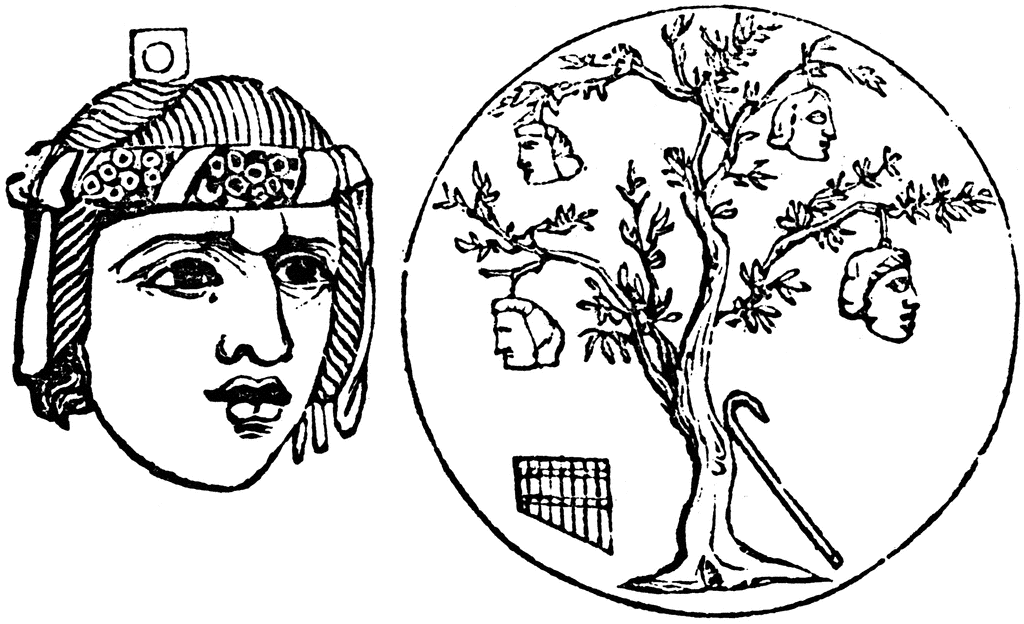
About the less rational aspects, the peasants had a lot superstitions and religious rites to increase the soil fertility.
Among the magical practices of the vineyard, I like very much the usage of hanging on the branches of the trees small masks of Bacchus, called oscilla (oscillum in the singular). The wind rotated them and it was believed that the part of the vineyard where the mask was turned would become very fruitful. (Virgil, The Georgics, II). They seem to me artistic installations.
Another more esoteric magical practice consisted in planting three goat horns in the earth around the plant to which the vines were trained (here I described the traditional Roman vine cultivation system, the vine “married” to the tree), with the part hollow upwards, slightly protruding from the ground. It was believed that the rain, which entered the horns and then passed into the soil, would give fertility.
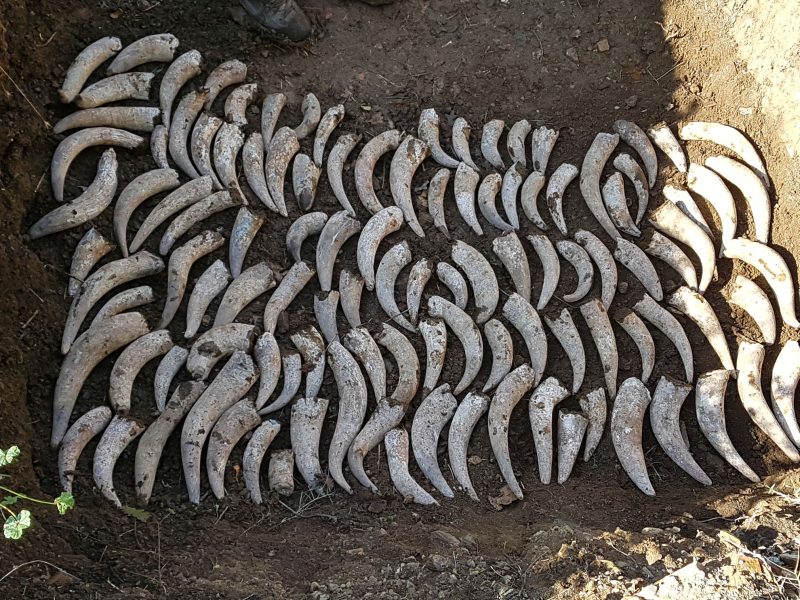
Several animals were often included in the propitiatory and fertility rites, through sacrifices or through the magical use of parts of their body (horns, bones, etc.). The anthropologists name it “magic by compensation“, because these animals were considered very dangerous for the vineyard. In addition to wild boar, fallow deer, deer and roe deer, which damage the vineyards even today, then there was still a large wild bovine, the wild ox (Bos taurus primigenius L.). The oxen that worked the vineyard were muzzled, so as not to damage the vines and other plants. Another great danger came from the flocks that had escaped the control of the shepherds. The goat was considered the main enemy of the winegrower. Not surprisingly, it was the sacrificial animal par excellence to the god Bacchus.

The horns, in particular, have taken on many symbolic meanings among different peoples and in various eras, including those of strength and fertility, as well as protection from evil influences. By contrast, Christianity put them on the heads of devils. Today, they curiously return in to the vineyards.
Vine diseases.
The vine diseases are probably the weakest part of the texts of the Latin agronomists, including the great Columella. On the other hand, the good practice and observation skills are not sufficient in this field. They lacked of in-depth knowledge on the nature of diseases and pests, the vine physiology, chemistry, etc. They will only come from the nineteenth century onwards. Despite this, we can find an attempt at rational research in their writings which shows some interesting ideas.
As we shall see, even this problematic area easily fell prey to the superstitions and the magical practices, which are often the result of the impotence. The life of farmers from the past was certainly not easy.
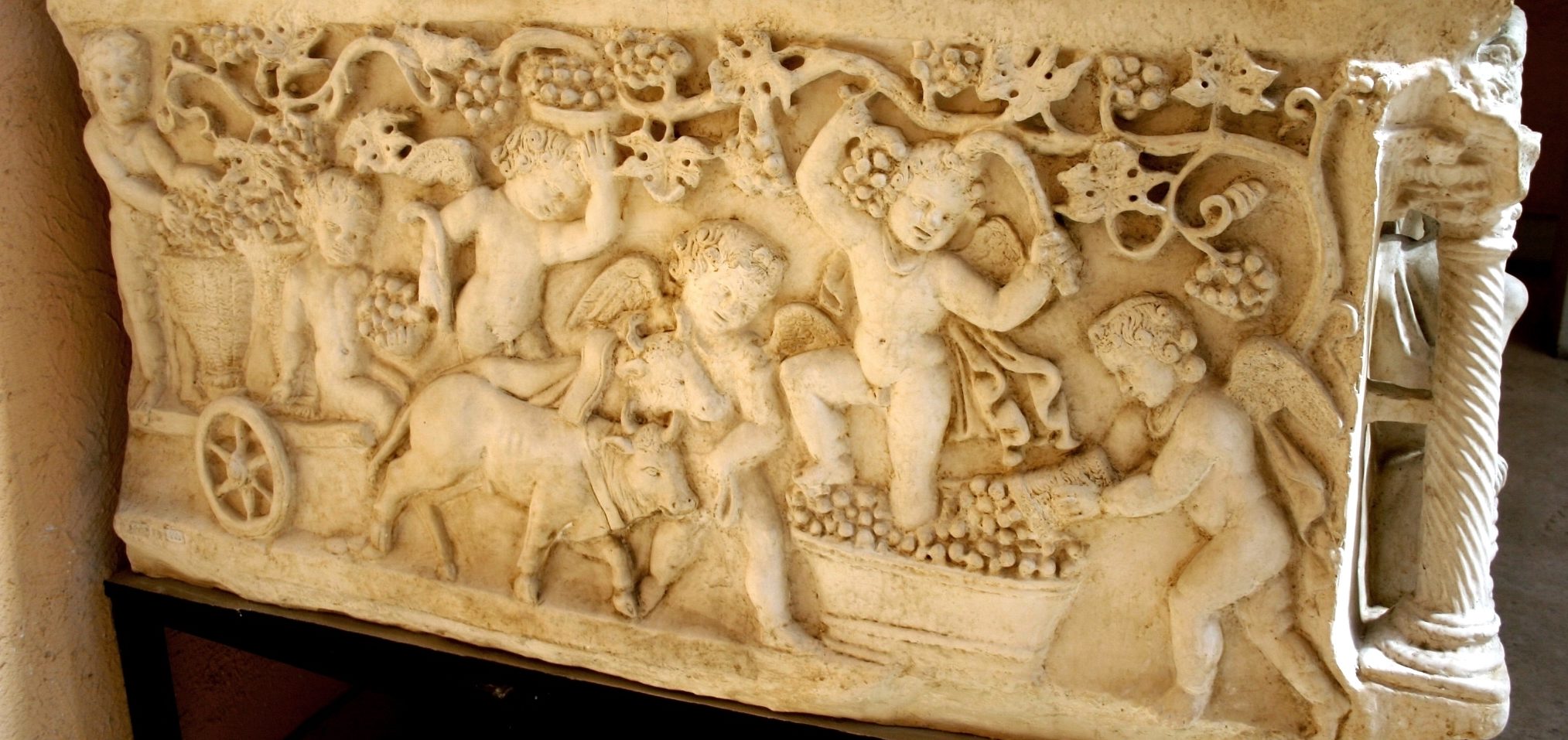
Fortunately, our Roman ancestors (and for many centuries after) have saved themselves from the worst diseases of the vineyard, capable of truly bringing winemakers to their knees. They arrived in Europe only in the nineteenth century, from America: phylloxera, powdery mildew and downy mildew.
There were the local diseases. However, they are less destructive than the American ones: they mostly affect the bunch and, except in particularly severe cases, they can be better “endured” by the winegrowers (although losing quality and quantity of the production). Sometimes, the local diseases can be contained by eliminating the first signs of infection, or by making a selection of the bunches.
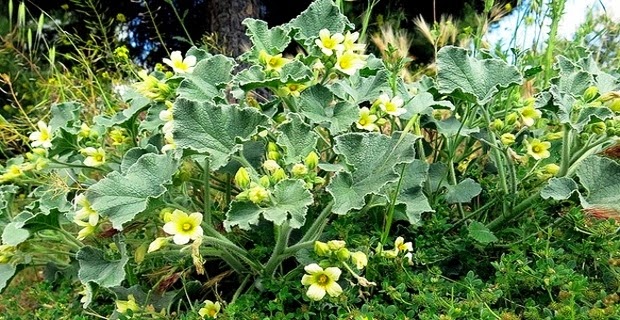
The Latin agronomists recommended for various diseases the use of substances that they thought to have “disinfectant” functions. They often suggested the use of the vinegar or elaterium-based poultices (Ecballium elaterium L., also called squirting cucumber or exploding cucumber), with which to rub the infected vine parts. The elaterium is a wild Mediterranean plant, used in the past also for its purgative effects, but abandoned for its high toxicity. There are not evidences of the utility of these compounds in the viticulture.
A recurring remedy was sprinkling vines with human old urine. We know it is not useful against the diseases. However, the urine gives nitrogen, a little phosphorus and potassium. Perhaps, it was recommended by the ancients because they observed a certain beneficial effect, simply as a form of fertilization. Actually, we know that the excess of nitrogen promotes certain vine diseases but, perhaps, at the time there were more deficiencies than abundances of nutrients.
To prevent diseases and problems due to frosts or humidity, Columella recommends burning piles of straw in the vineyards or spreading hot ash on the vines. Even today, the winegrowers try to avoid frost damage by lighting fires in the vineyard in the colder places.
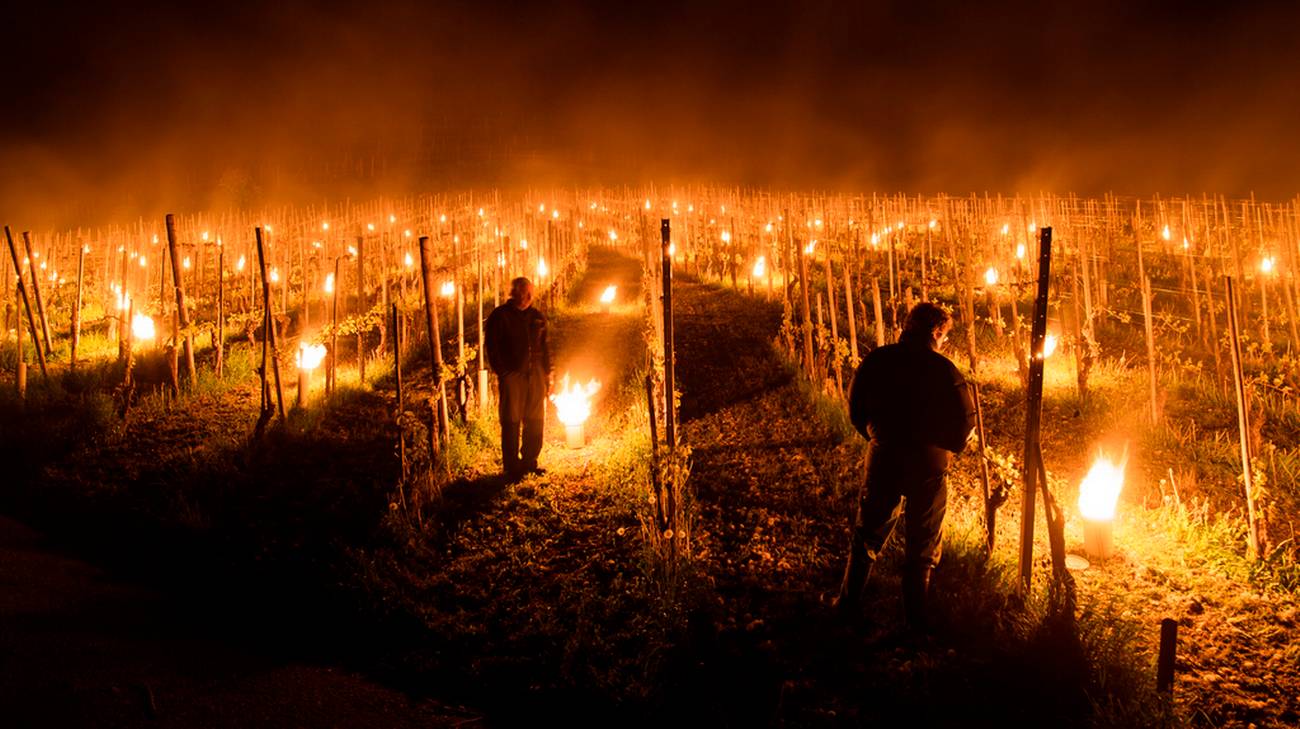
It is not easy to recognize the diseases and pests that we know to infest the vineyard from the descriptions of the Latin authors. They are too poor and vague, we can made only hypotheses. For example, they speak of vines that do not emit fruit, the leaves turn white and dry out. From the symptoms, it looks like a mold, most likely botrytis at an early stage. In this case, the recommended remedy was to rub the plants with very strong vinegar, mixed with ash, and pour it, diluted, on the roots.
They described diseased vines with the leaves that turning red (the esca desease?). The recommendation is to drill the trunk and to insert an oak branch or a stone, or nails, into the hole. Do not be surprised: cutting operations on the trunk are also done today with often positive results, because it is a disease that affects the lymphatic vessels of the plant and the wood. Another ancient advice was to cut the vines near the ground, cover them with some earth and dung and re-start the growing. This also makes sense, considering also that the vines were not grafts like today (because of the phylloxera).
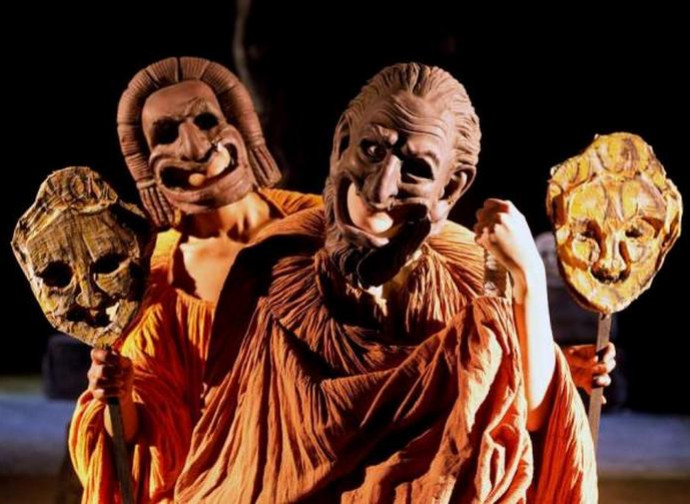
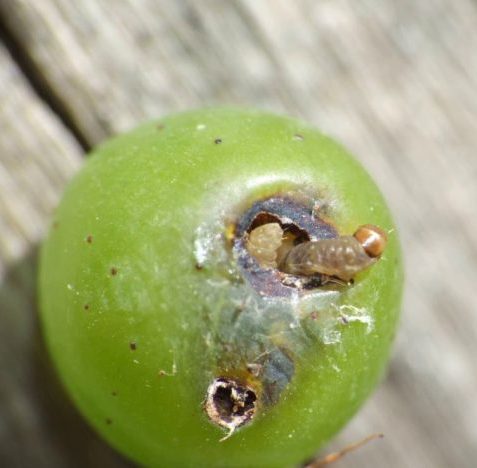
Several authors cite small beasts which create damage to the vine, which erode its tender shoots and fruits or which alter the leaves. Cato speaks of small “caterpillars”. Plautus, an author of comedies, compares a particularly annoying character to the involvolus, who defines “bestiam et damnificam, quae in pampini folio intorta se“, “an evil animal, which rolls up in the vine shoot” (La Cistellaria, Act IV, Sc. II, v.63). Pliny speaks of convolvulus and araneum (web), Columella about volucre. It is not clear whether they speak of the same or more pests. Some modern authors have thought of recognizing in certain descriptions the larval forms of the vine moth and the mites, parasites very common in the vineyards. Cato recommends the use of a mixture of cooked oily deposit, bitumen and sulfur. The latter is one of the oldest plant protection products. It is still used today in pest management, albeit against other diseases (powdery mildew). In certain situations, it can actually give secondary effects on mites.
Other ancient practices are instead truly inexplicable: they seem naive attempts or linked to superstitions and magical beliefs. Many things were burned or buried in the vineyard against disease and bad luck: horns, fishes, shrimps, various plants, goat or ox dung. They rubbed the sickles with bear’s blood or with gelding skin, for “purifying” purposes. It was recommended to prune the vineyard on a full moon night to disinfest the vines closest to the houses from mice. Some recommendations in this sense are present in the Columella’s latest book “On the Trees”, whose attribution is however uncertain. According to several scholars, it could be a spurious work, perhaps by a certain Gargilius Martialis, who copied large parts of the writings the well-known author and introduced passages in his own hand, of a completely different level than the original treatise.
 Listen how this compound is prepared, which should keep vine diseases away. Collect some oak bark, removing it from the trunk with a planer, in early autumn. Finely mince the bark and put it in the skull of a pet, passing through the hole at the base (from which the spinal cord enters). Press well and close the hole with a bone fragment and clay. Bury the skull on the edge of a pond, in the presence of rotting plant material. In the spring, take off the content and dried it. Then, dissolve infinitesimal quantities of it in rainwater, mixing with certain movements, three times to the right and three to the left, …
Listen how this compound is prepared, which should keep vine diseases away. Collect some oak bark, removing it from the trunk with a planer, in early autumn. Finely mince the bark and put it in the skull of a pet, passing through the hole at the base (from which the spinal cord enters). Press well and close the hole with a bone fragment and clay. Bury the skull on the edge of a pond, in the presence of rotting plant material. In the spring, take off the content and dried it. Then, dissolve infinitesimal quantities of it in rainwater, mixing with certain movements, three times to the right and three to the left, …
What I have just described is not a practice of Roman times, but of today (it is part of biodynamics). It looks a lot like what were already considered superstitions two thousand years ago. Different strange ingredients are used, as the cow horns or deer bladders, for other preparations, buried on full moon nights, … They are not even simple to prepare: luckily, you can comfortably purchase them, sold by companies ready to satisfy these modern needs of magic.
Gods of the vineyard
The ancient winegrowers also prayed gods to solve problems of fertility or various adversities, with rites and sacrifices.
About wine, everyone thinks essentially to Bacchus, a god originally linked to the force of nature and its cycles. However, he arrived in Rome only at the end of the third century. BC, from Greece and first passing through Etruria, inserting him in pre-existing cults. We know him well, so I won’t go on. I report only what seemed to me a sort of winemaker’s prayer, written by Virgil at the beginning of the second book of the Georgics:
[one_second][info_box title=”Gods of the vineyard and the soil fertility” image=”” animate=””]

The viticulture in Rome was mainly protected by Jupiter, who had close ties to nature and, in particular, to the vineyard. In fact, the celebrations preceding the harvest were dedicated to him.
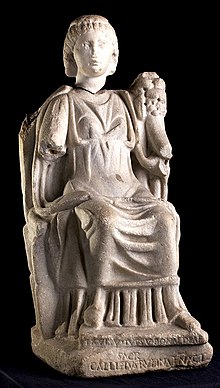
A cult linked to the land is that of the triad Ceres, Liber and Libera. Libera was the Mother Goddess, later goddess of the fertility of the fields. Liber was her son-vegetation who dies and returns every year. In other versions, Liber and Libera were the two sons of the Mother Goddess Ceres, later goddess of fertility and crops. Later, Liber became the dominant figure, with the name of Liber Pater (Father), linked in particular to fertility. The tools of the harvest and the wine-cellar were consecrated to him and to Libera. He was later assimilated (in part) to Bacchus. I remember also the goddess Dia or Bona Dea, ancestral Mother Goddess, who remained as protector of the farmers and the female fertility. She was the wife of Faunus, god of the countryside, the pastures and the agriculture. The goddess Tellus presided over all the earth, from agricultural wealth to mining and to the dead.
Janus was a very ancient local God. According to Virgil (Aeneid), he was the king of the Aborigines, a primitive people inhabiting the mountains. He taught them the agriculture and the religion. Another myth describes him as the founder of one of the villages from which Rome was born, on the Janiculum hill. A myth tells that he hosted the god Saturn, when he had been expelled by Jupiter. His arrival marked the beginning of the Golden Age, an era of great agricultural abundance. In return, Janus received the power to see the past and the future, becoming the Two-faced God, symbol of the beginning and the end of the year. Another myth tells that it was Saturn who gave the wine to the King Janus.
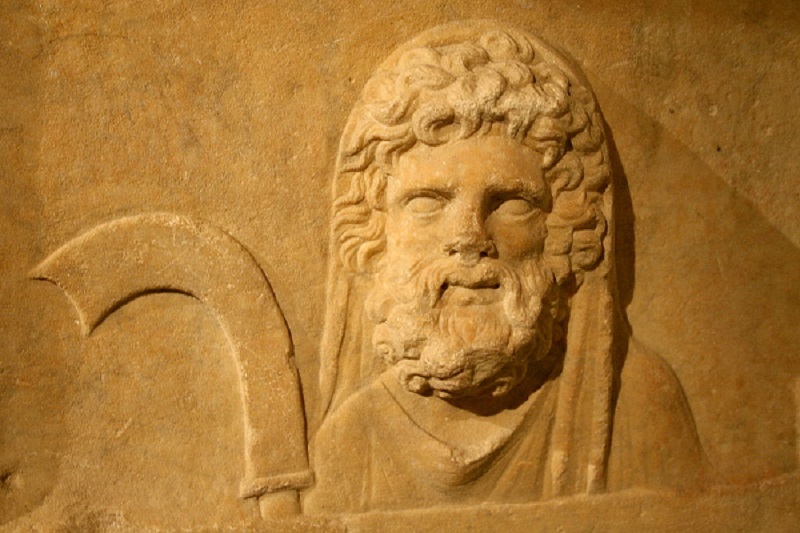
There is an even more ancient and local tradition of Saturn, told by Cato, in which he is described as a god winemaker who came down from the Sabine mountains. His wife is Opi, the Sabine Mother Goddess, who later became goddess of agricultural abundance in Rome. He tought the domestication of useful plants, the teaching of the art of grafting, of the cultivation of vines and of the beekeeping. He was always represented with a sickle in his hand, the tool symbol of the winegrower. People had to offered him some spelled soaked in lard and wine. Other very ancient and local gods were the couple Robigus and Robiga, the wheat protectors from the stem rust (a disease caused by a fungus), also invoked to protect the vineyard from diseases resulting from humidity and rain.
In the subjugated territories, the local deities remained as the main reference, such as the Mother Goddess Feronia, protector of agriculture among several peoples of the central Italy (Volsci, Latins, Marsi, Umbri and Etruscans). Helvius was the god of the Samnites who favored the fruit picking and the harvest, … Among the Greek divinities assimilated, I also remember Priapus, depicted with a huge phallus, an expression of male sexuality, the human fertility and the vegetation one. His cult in Italy was mainly linked to the protection of vegetable gardens, vineyards and gardens from thieves (humans, but also birds or other animals). The god’s effigy was placed at their entrance. [/info_box][/one_second]
“Here, O Bacchus Father, here all is filled with your gifts, the vineyard flourishes filled with autumnal vine shoots, the grape harvest foams in the brimming vats;
here, O Bacchus Father, come, and, free of footwear plunge naked feet, with me, in the new vintage.”
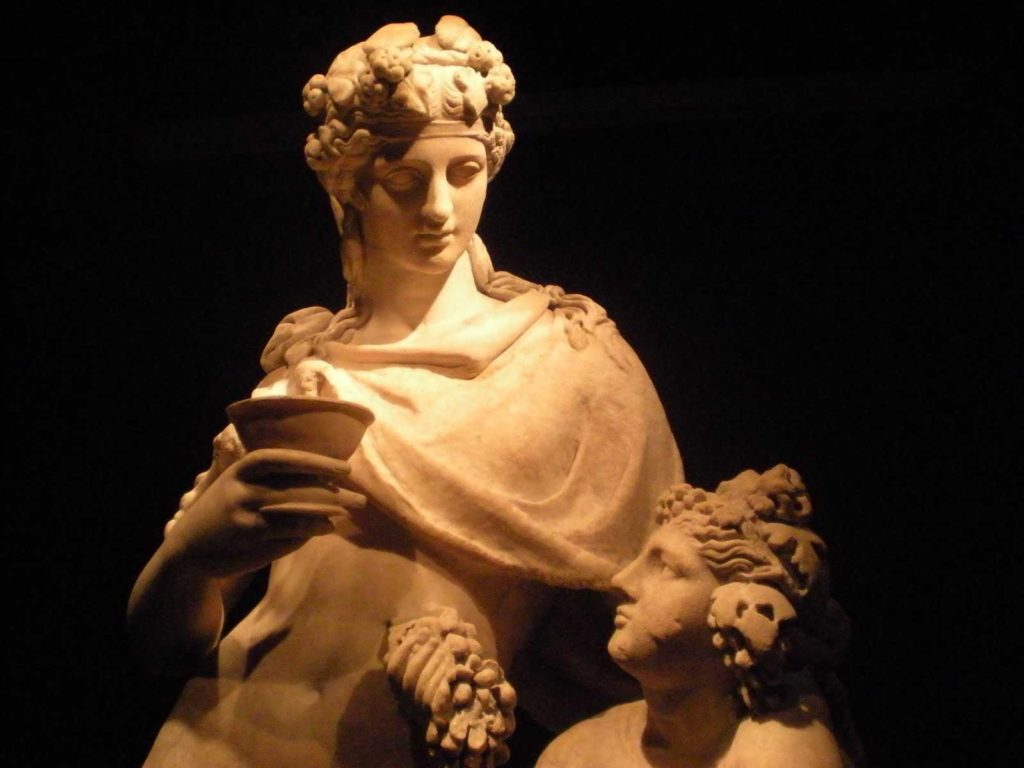
HUC, PATER O LENAEE*, TUIS HIC OMNIA PLENA
MUNERIBUS, TIBI PAMPINEO GRAVIDUS AUTUMNO
FLORET AGER, SPUMAT PLENIS VINDEMIA LABRIS;
HUC, PATER O LENAEE, VENI, NUDATAQUE MUSTO
TINGUE NOVO MECUM DERPTIS CRURA COTHURNIS…
*Lenaeus is one of the several names Bacchus.
In reality, there were numerous divine figures which a Roman winemaker could have prayed. The Roman gods linked to the land, the soil fertility and the agriculture were very numerous, with overlaps and connections often difficult to understand for us. Originally, Roman religion worshiped numen / (plural) numina, who were not personification, but acts of the divine power, expressions of the multiple aspects of each natural phenomena. The influence of other cultures (Etruscan, Greek, etc.) brought the Roman to give them ever more human form, stories and hierarchies, more or less from the late Republic. However, the original cultural imprint remained. This explains the absolute tolerance and assimilation of the Romans towards the divinities of other peoples. The only limitation was that the new cult did not create social or political dangers. However, with the laic lucidity of many great Roman authors, Varro wrote that originally what was useful was worshiped.
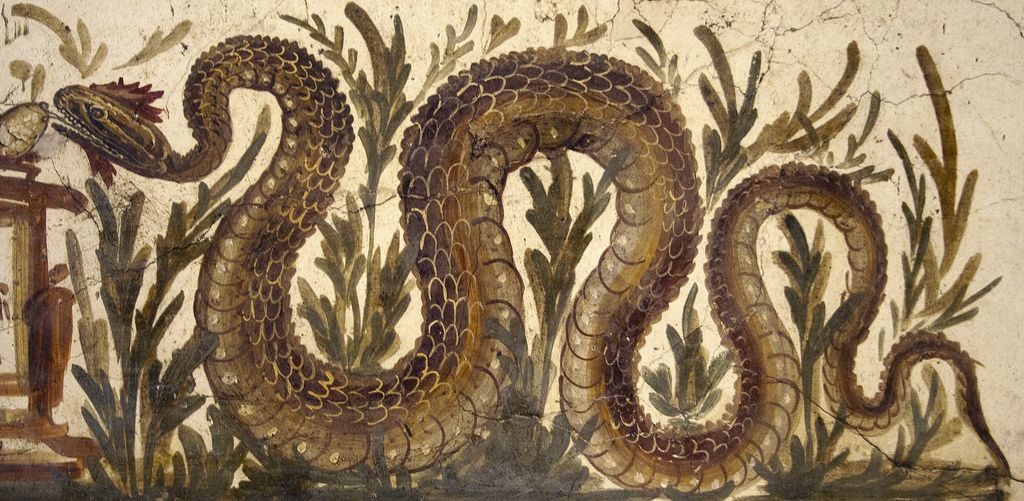
In the countryside, the most loved and revered were often the local divine figures, even “minor” ones, but that the peasants felt closer to them. To the deities listed in the box, we add the Genius loci, the genius of the place, depicted as a snake or winged figure (of which I have told here) or the Nymphs, tied to sources or woods or certain places, …
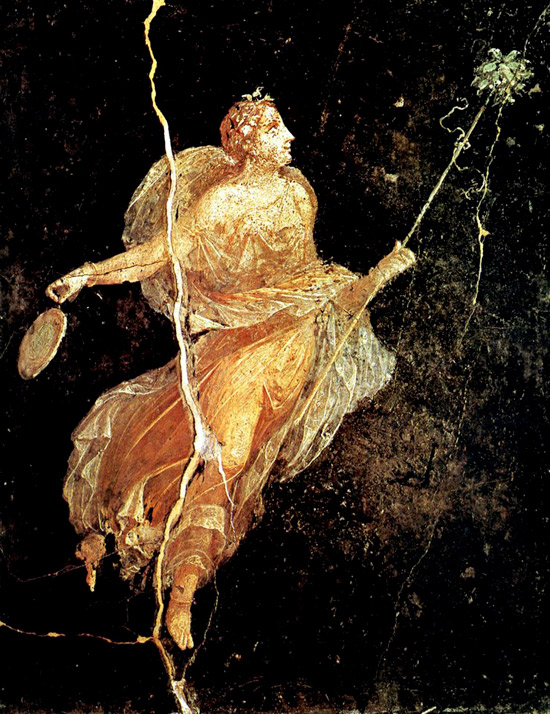 Furthermore, every single agricultural practice had its tutelary deity, in an incredibly specific way. Servius lists some of them (Ad Georg., I, 21): Deus Vitisator (the god who presides over the vineyards planting), Vervactor (for the haymaking), Reparator (for the repairs, the arrangements of waterways and the fences, …), Obarator (for the plowing) , Imporcitor (for the sowing), Insitor (for the grafting), Occator (for the harrowing), Sarritus (for the hoeing), Subruncinator (for the hoeing for the weeding), Messor (for the reaping), Convector (for the transport), Conditor (for the piling of hay, wheat or straw), Promitor (for the taking away from the stockpiles of hay, wheat or straw), etc.
Furthermore, every single agricultural practice had its tutelary deity, in an incredibly specific way. Servius lists some of them (Ad Georg., I, 21): Deus Vitisator (the god who presides over the vineyards planting), Vervactor (for the haymaking), Reparator (for the repairs, the arrangements of waterways and the fences, …), Obarator (for the plowing) , Imporcitor (for the sowing), Insitor (for the grafting), Occator (for the harrowing), Sarritus (for the hoeing), Subruncinator (for the hoeing for the weeding), Messor (for the reaping), Convector (for the transport), Conditor (for the piling of hay, wheat or straw), Promitor (for the taking away from the stockpiles of hay, wheat or straw), etc.
The Christianity struggled much more to eradicate these local peasant cults, widespread in the countryside, than those of the main deities in the cities. It did it by simply carrying out a replacement operation: these figures became the patron saints or local cults of Madonna. In the same way, many ancient holidays related to the agricultural world have survived, absorbed by Christian holidays or became traditional agricultural fairs.
The Italian writer Carlo Levi, confined to Basilicata region by the fascist regime, was fascinated by the discovery of the existence of rural archaic cults and told it in his work “Christ stopped at Eboli” (1945). About the cult of a local Black Madonna, he wrote:
[blockquote author=”” link=”” target=”_blank”]”The dark-faced Madonna, between the wheat and the animals, the gunshots and the trumpets, was not the pitiful Mother of God, but an underground divinity, black, of the shadows of the womb of the earth, a peasant Persephone, an infernal Goddess of the crops.
…
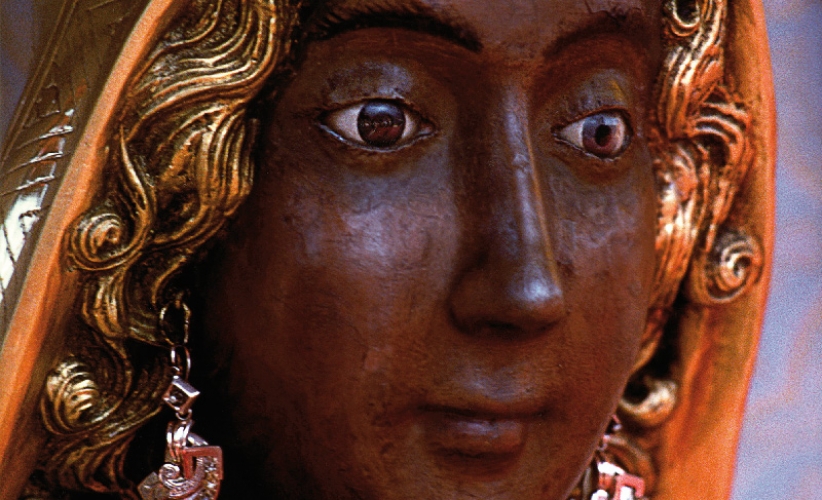
The earth was too hard to work it, the olives began to dry out on thirsty trees; but the black-faced Madonna remained impassive, far from the pity, deaf to the prayers, indifferent nature. Yet the tributes are not lacking: but they are much more similar to the tribute due to the Power, than to that offered to Charity.
This black Madonna is like the Earth; she can do everything, to destroy and to flourish; but she doesn’t know anyone, and she carries out the seasons according to her incomprehensible will.
The black Madonna is not neither good nor bad for the peasants; she is much more. She dries the crops and she let to die, but she also nourishes and protects; and you have to worship her.
In all the houses, at the head of the bed, attached to the wall with four nails, the Madonna of Viggiano attends to all the acts of the life, with her big eyes without a gaze in the dark face.”[/blockquote]
Bibliography:
“De re rustica”, Lucio Giunio Moderato Columella (60-65 d.C.), tranlated by Giangirolamo Pagani, 1846 (I prefer the nineteenth century translations because, having a vineyard practices and wine production techniques more similar to the old ones respect ours, they know better explain the concepts and find the right words. The modern translaters often fall into error on the agricultural terms).
“Interventi di bonifica agraria nell’Italia romana”, a cura d Lorenzo Quilici e Stefania Quilici Gigli, ed. L’Erma di Bretchneider, 1995.
“Storia dell’agricoltura italiana: l’età antica. Italia Romana” a cura di Gaetano Forni e Arnaldo Marcone, Edizioni Polistampa, 2002
“La viticoltura e l’enologia presso i Romani”, Luigi Manzi, 1883, .
“Storia della vite e del vino in Italia”, Dalmasso e Marescalchi, 1931-1933-1937, .
“Storia del paesaggio agrario italiano”, Emilio Sereni, 1961, .
“Quando le cattedrali erano bianche”, Quaderni monotematici della rivista mantovagricoltura, il Grappello Ruberti nella storia della viticoltura mantovana, Attilio Scienza.
“Terra e produzione agraria in Italia nell’Evo Antico”, M. R. Caroselli.
“Le tignole della vite”, G. Anfora et al., Istituto Agrario di San Michele all’Adige, 2007.
http://narrabilando.blogspot.com/2014/05/culti-pagani-e-culti-cristiani.html